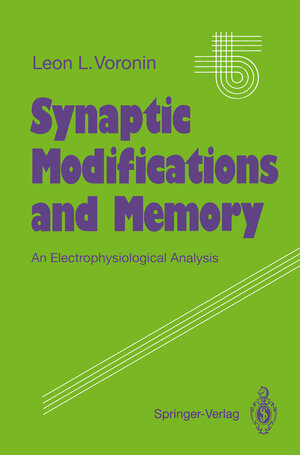
×
![Buchcover ISBN 9783642476150]()
Inhaltsverzeichnis
- 1 Hippocampal Long-Term Potentiation and Its Characteristics.
- 1.1 Brief Overview of the Structure of the Hippocampus.
- 1.2 Electrical Responses of the Hippocampus.
- 1.3 Initial Experiments on Long-Term Potentiation.
- 1.4 Working Hypothesis and Early Results.
- 1.5 Methods.
- 1.6 Long-Term Potentiation of Field Potentials in the CA3 and CAI Regions.
- 1.7 Low-Frequency Depression and Self-Restoration of the Potentiated Response.
- 1.8 Specificity of Long-Term Potentiation for the Tetanized Input.
- 1.9 Involvement of Reinforcing Systems During Tetanization.
- 1.10 Discussion.
- 1.11 Summary.
- 2 Unitary and Minimal Postsynaptic Potentials (Literature Review).
- 2.1 Introduction.
- 2.2 Methods Related to Unitary and Minimal PSP Recording.
- 2.2.1 Intracellular Stimulation of the Afferent Unit.
- 2.2.2 Macrostimulation of Afferent Fibres.
- 2.2.3 Intracerebral Microstimulation.
- 2.2.4 Recording of “Minimal” PSPs.
- 2.2.5 Additional Procedures for the Detection of Single UPSPs.
- 2.2.6 Measurements of UPSPs and MPSPs Amplitudes and PSCs.
- 2.2.7 Mono- and Polysynaptic UPSPs.
- 2.3 Unitary Field Potentials — “EEG Quanta”.
- 2.4 Applications of Unitary and Minimal PSP Recordings.
- 2.4.1 Organization of Neuronal Connections.
- 2.4.2 Electrical and Chemical Synapses in the CNS.
- 2.4.3 Spatial Organization of Synapses on the Somadendritic Membrane.
- 2.5 Studies of Synaptic Plasticity in the CNS.
- 2.5.1 Introductory Remarks.
- 2.5.2 Habituation and Sensitization in Invertebrate CNSs.
- 2.5.3 Conditioning Mechanisms in the Aplysia CNS.
- 2.5.4 LFD in the Vertebrate CNS.
- 2.6 Conclusions.
- 2.7 Summary.
- 3 “Minimal” Field Potentials of the Hippocampus and Their Post-Tetanic Changes.
- 3.1 Introduction.
- 3.2 Methods.
- 3.3 Field Potentials Correlated with Neuronal Discharges from theContralateral Hippocampus.
- 3.4 Field Activity After Spikes of the Schaffer Collaterals.
- 3.5 Minimal Field Potentials.
- 3.6 Post-Tetanic Changes of Minimal FPs.
- 3.7 Discussion.
- 3.8 Summary.
- 4 Excitatory Postsynaptic Potentials of Hippocampal Neurones and Their Low-Frequency Depression.
- 4.1 Introduction.
- 4.2 Methods.
- 4.3 Responses to Single Stimuli.
- 4.4 Responses to Paired Stimuli of Different Amplitudes.
- 4.5 Changes of EPSPs During Low-Frequency Stimulation.
- 4.6 Changes of IPSPs During Low-Frequency Stimulation.
- 4.7 Discussion.
- 4.8 Summary.
- 5 Responses of Hippocampal Neurones During Long-Term Potentiation.
- 5.1 Introduction.
- 5.2 Methods.
- 5.3 General Description of Neuronal Responses.
- 5.4 Short-Term Post-Tetanic Changes.
- 5.5 Long-Term Changes in Spike Responses after Tetanization.
- 5.6 Post-Tetanic Changes of Postsynaptic Potentials.
- 5.7 Post-Tetanic Changes in Excitability and Resting Membrane Potential.
- 5.8 Discussion.
- 5.9 Summary.
- 6 Changes in Acetylcholine Sensitivity During Long-Term Potentiation.
- 6.1 Introduction.
- 6.2 Effects of Acetylcholine Iontophoresis on Cellular and Field Responses.
- 6.3 Changes in ACh Sensitivity During LTP.
- 6.4 Discussion.
- 6.5 Summary.
- 7 Quantal Analysis of Postsynaptic Potentials (Literature Review).
- 7.1 Introduction.
- 7.2 Principles of the Quantum Hypothesis.
- 7.3 Methods of Determination of the Mean Quantal Content.
- 7.3.1 Direct Counting of Quantal Contents of Single PSPs.
- 7.3.2 The Method of “Miniatures”.
- 7.3.3 Histogram Method.
- 7.3.4 Method of Failures.
- 7.3.5 Method of the Coefficient of Variation.
- 7.3.6 Analysis of Dispersions.
- 7.3.7 Deconvolution Technique.
- 7.3.8 Other Methods.
- 7.4 Corrections for the Methods of Estimating m.
- 7.4.1 Non-Linear Summation.
- 7.4.2 Control of Steady State.
- 7.4.3“Non-Specific” Activity.
- 7.4.4 Multicomponent Miniature PSPs.
- 7.4.5 Additional Remarks.
- 7.5 Poisson and Binomial Distributions of PSP Amplitudes.
- 7.6 Methods of Estimating Binomial Parameter p.
- 7.6.1 Variance of Quantal Distribution.
- 7.6.2 Variances of Amplitudes of PSPs and mPSPs.
- 7.6.3 Division of Amplitude Histogram According to µ.
- 7.6.4 Automatic Computation when v Is Known.
- 7.6.5 Automatic Analysis of Amplitude Distributions.
- 7.6.6 Combination of Variance and Failures Methods.
- 7.6.7 Other Methods.
- 7.7 Additional Explanations to Methods of Computing Quantal Parameters.
- 7.7.1 Non-Stationarity and Non-Uniformity.
- 7.7.2 Models with Non-Uniform p.
- 7.7.3 Other Modifications.
- 7.8 Basic Quantal Parameters for Various Junctions.
- 7.8.1 Neuromuscular Junctions and Autonomic Ganglia.
- 7.8.2 Invertebrate CNS.
- 7.8.3 Spinal Cord.
- 7.8.4 Cerebrum.
- 7.8.5 Hippocampus.
- 7.9 Binomial Parameters n and p for Various Junctions.
- 7.9.1 Neuromuscular Junctions and Autonomic Ganglia.
- 7.9.2 Invertebrate CNS.
- 7.9.3 Spinal Cord.
- 7.9.4 Cerebrum.
- 7.10 Quantal Analysis of Synaptic Plasticity.
- 7.10.1 Various Applications of Quantal Analysis.
- 7.10.2 Frequency Facilitation (FF).
- 7.10.3 Frequency Depression (FD).
- 7.10.4 Post-Tetanic Potentiation (PTP) and Heterosynaptic Facilitation (HSF).
- 7.10.5 Long-Term Facilitation (LTF).
- 7.11 Conclusions.
- 7.12 Summary.
- 8 Application of Quantal Analysis to Central Synapses.
- 8.1 Introduction.
- 8.2 Methods.
- 8.3 Consideration of Known Methods of Determination of Quantal Parameters.
- 8.4 The Histogram Method.
- 8.5 Method Based on the Ratio of the Mean to Maximal Amplitude.
- 8.6 Quantal Parameters of Unitary EPSPs of Snail CNS.
- 8.7 Theoretical Distributions of PSP Amplitudes.
- 8.8 Discussion.
- 8.9 Summary.
- 9 Models ofTransmitter Depletion and Their Application to Analysis of Synaptic Plasticity (Literature Review).
- 9.1 Introduction.
- 9.2 Basic Model Parameters and Recording Conditions.
- 9.3 Model of Transmitter Depletion Without Mobilization.
- 9.3.1 Method of Paired Stimulation.
- 9.3.2 Method of Amplitude Dependence on Serial Stimulus Number During Frequency Stimulation.
- 9.3.3 Method of Relationship Between Amplitude and Sum of Amplitudes of Previous Responses.
- 9.4 Model of Transmitter Depletion with Mobilization.
- 9.4.1 Restoration after Stimulation Method of Paired Stimulation.
- 9.4.2 Frequency Stimulation. “Continuous” Model.
- 9.4.3 Approximate Estimates of Parameters of the Continuous Model.
- 9.4.4 Frequency Stimulation. “Discrete” Model.
- 9.5 Modifications of the Depletion Model for Variable F.
- 9.5.1 Model of “Partial Depletion”.
- 9.5.2 “Partial Depletion” with Paired Stimulation.
- 9.6 Transmitter Mobilization and Parameters of the Store Pool.
- 9.6.1 Relationship Between Mobilization and Stimulus Frequency.
- 9.6.2 Dependence of Mobilization on Time.
- 9.6.3 Total Transmitter Store.
- 9.7 Depletion Model in Studies of Synaptic Plasticity.
- 9.7.1 Applications of the Depletion Model and Simple Synaptic Plasticities.
- 9.7.2 Frequency Depression and Postactivation Depression.
- 9.7.3 Postactivation Facilitation.
- 9.7.4 Frequency Facilitation.
- 9.7.5 Post-Tetanic Potentiation.
- 9.8 Conclusion.
- 9.9 Summary.
- 10 Parameters of Transmitter Depletion Model for Snail Central Synapses and Comparison of Depletion and Quantal Models.
- 10.1 Introduction.
- 10.2 Discrete Model of “Partial” Transmitter Depletion.
- 10.3 Discrete Model with Arbitrary Changes in F.
- 10.4 EPSP Changes During Stimulation.
- 10.5 Calculation of Parameters by Basic Methods of the Depletion Model.
- 10.6 Calculation of Parameters by Method 10.3.
- 10.7 Comparison of Parameters of Depletion and Quantal Models.
- 10.8 Discussion.
- 10.9 Summary.
- 11 Quantal Analysis of Short-Term Plasticities at Central Synapses.
- 11.1 Introduction.
- 11.2 Paired-Pulse Facilitation of Hippocampal Responses.
- 11.3 Low-Frequency Depression of Hippocampal Responses.
- 11.4 Low-Frequency Depression at Snail Central Synapses.
- 11.5 Paired-Pulse Facilitation in Hippocampal Slices.
- 11.6 Discussion.
- 11.7 Summary.
- 12 Quantal Analysis of Hippocampal Long-Term Potentiation in Vivo.
- 12.1 Introduction.
- 12.2 Methods.
- 12.3 Unitary Postsynaptic Potentials of Hippocampal Neurones.
- 12.4 Post-Tetanic Changes in Postsynaptic Potentials Evoked by Microstimulation.
- 12.5 Statistical Analysis of Minimal EPSPs Evoked by Microstimulation.
- 12.6 Changes in Quantal Parameters After Tetanization.
- 12.7 Discussion.
- 12.8 Summary.
- 13 Quantal Analysis of Minimal Postsynaptic Potentials in Hippocampal Slices: Binomial Model.
- 13.1 Introduction.
- 13.2 Methods.
- 13.3 Results of Computer Simulations.
- 13.3.1 Testing Different Methods.
- 13.3.2 Testing Methods of p Determination.
- 13.3.3 Testing “Objective” Method of Failures Determination.
- 13.4 Results of Physiological Experiments.
- 13.4.1 General Description.
- 13.4.2 Testing EPSP Amplitude Stability.
- 13.4.3 Comparison of Parameters Calculated from Different Samples.
- 13.4.4 Objective vs. Subjective Method of Failures Determination.
- 13.4.5 Comparison of Different Methods.
- 13.4.6 Optimization of Noise Standard Deviation.
- 13.4.7 Mean Quantal Parameters of Hippocampal Synapses.
- 13.5 Discussion.
- 13.5.1 Simulation Experiments.
- 13.5.2 EPSP Measurements and Noise Reduction.
- 13.5.3 Testing Procedures and Sample Sizes.
- 13.5.4 Applicability of the QuantumHypothesis and Simple Binomial Model.
- 13.5.5 Noise Reduction During EPSP.
- 13.5.6 Quantal Parameters of Hippocampal Synapses.
- 13.6 Summary.
- 14 Binomial Analysis of Long-Term Potentiation of Minimal EPSPs in Hippocampal Slices.
- 14.1 Introduction.
- 14.2 Methods.
- 14.3 Results.
- 14.3.1 Long-Term Potentiation of Minimal EPSPs.
- 14.3.2 Estimates of Quantal Parameters.
- 14.3.3 Post-Tetanic Changes in Mean Quantal Content.
- 14.3.4 Post-Tetanic Changes in Quantal Size.
- 14.3.5 Post-Tetanic Changes in Binomial Parameters.
- 14.3.6 Differential Changes in m and v for Different LTP Magnitudes.
- 14.4 Discussion.
- 14.5 Summary.
- 15 Analysis of Fluctuations of Minimal EPSPs in Vitro: Quantal Model.
- 15.1 Introduction.
- 15.2 Methods.
- 15.3 Results of Simulation Experiments.
- 15.4 Results of Physiological Experiments.
- 15.5 Discussion.
- 15.5.1 Reliability of the Deconvolution Procedure.
- 15.5.2 Post-Tetanic Changes in Quantal Parameters.
- 15.5.3 Differential Changes in Quantal Parameters at Different LTP Magnitudes.
- 15.5.4 Two Types of Synaptic Mechanisms of LTP Maintenance.
- 15.6 Summary.
- General Conclusions.
- References.



